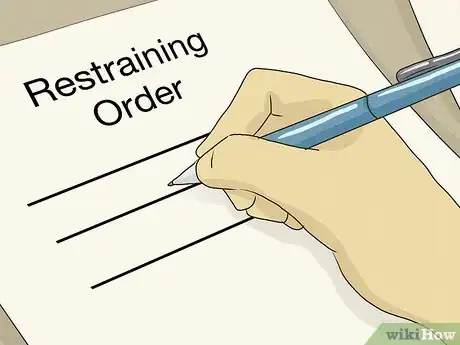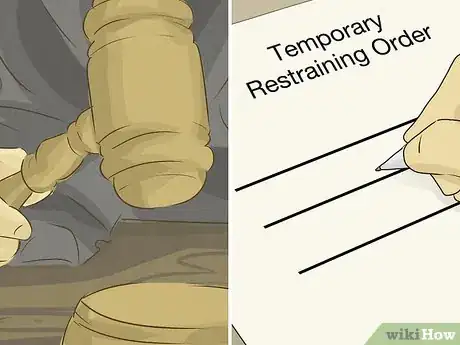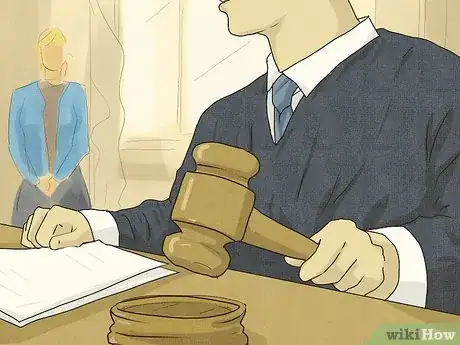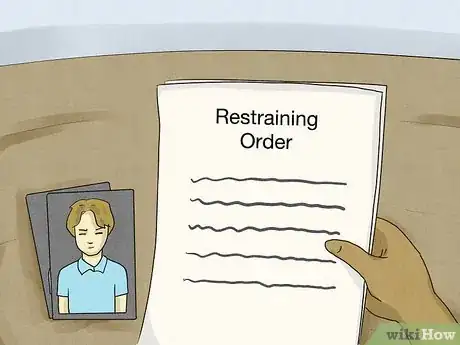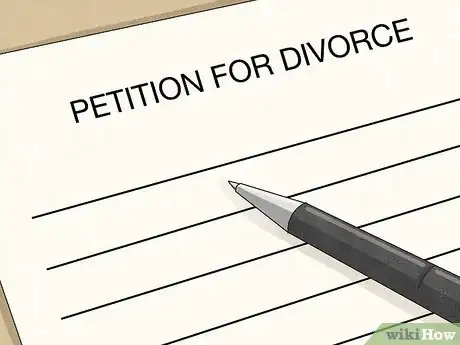This article was co-authored by Scott Levin. Scott Levin is a Divorce Mediator & Family Lawyer, as well as the Founder of San Diego Divorce Mediation. With nearly 20 years of experience, he specializes in peacefully mediating divorces so couples split amicably. He holds a law degree from the University of Chicago School of Law and a Bachelor’s degree in Metropolitan Studies from New York University. Additionally, Scott is a licensed attorney in California, a Certified Divorce Financial Analyst, and a member of The Academy of Professional Family Mediators.
There are 10 references cited in this article, which can be found at the bottom of the page.
wikiHow marks an article as reader-approved once it receives enough positive feedback. In this case, 100% of readers who voted found the article helpful, earning it our reader-approved status.
This article has been viewed 226,713 times.
Everything started out perfect, making it easy for you to deny or excuse the abuse as it evolved. But now you've reached your breaking point and decided to leave your abusive spouse. Good for you! It takes strength and confidence to get out of an abusive relationship. Divorce can be traumatic enough even without the threat of domestic violence, but with legal assistance and the support of family and close friends, you can get free and start your new life without having to constantly look over your shoulder or second-guess every choice you make.
Steps
Getting Out
-
1Set up new email and social media accounts. While you're making plans to get out of an abusive marriage, you kind of have to live a double life. If your spouse finds out you're trying to leave, they'll likely get angry and might get violent. Create new accounts they don't know about to communicate with anyone who's helping you.[1]
- Choose passwords that are different from anything you've used before and would be difficult for your spouse to guess.
- Only connect with people you trust on these accounts. Don't open them up to anyone who was your spouse's friend first, or who is part of your spouse's family. Your spouse might get some of these people to approach you and act as though they're on your side, then feed information back to your spouse. This is especially likely if your spouse thinks you're trying to leave, or if you've tried to leave before.
-
2Talk to a trusted friend or family member about being your ally. Although it's possible to get away on your own, it'll be a lot easier if you have someone helping you "on the outside." This should be someone who's comfortable taking calls or receiving mail for you, if necessary.[2]
- An abusive partner often tries to alienate you from others, so this can be more difficult than it sounds. Make sure it's someone you trust not to tell your spouse about your plans, even if they're pressured.
- If you feel comfortable talking to your boss at work, they might also be able to offer you some support and assistance, such as giving you time to organize your escape from work or a secure place to store your evidence.
Advertisement -
3Contact an attorney to discuss your situation. If possible, try to talk to an attorney before you get out of the house. After you leave, your spouse might try to call every family law attorney in the area and talk to them. Under conflict of interest rules, if he's already talked to them, they might not be able to take your case.[3] So get an attorney on board with you as soon as possible.[4]
- All of your conversations with an attorney are subject to attorney-client privilege, so you don't have to worry about your spouse finding out. However, you do want to make sure that you only contact your attorney using means your spouse can't trace, such as a friend's phone or a new email account your spouse doesn't know about.
- Search online for a local domestic violence shelter — they can typically connect you to a local attorney who can help you. They also have secure websites that don't leave information in your browser history that your spouse can use to find out you visited the site.
-
4Open a separate bank account in your name. Use a different bank than the one your spouse banks at. If you can't make it to a branch or are worried about your spouse finding out, look for an online bank account that you can open with no deposit.[5]
- Have your paycheck direct-deposited into your new account. If you're worried your spouse will notice if your paycheck is no longer deposited into the account they control, talk to someone in payroll about splitting the deposit into 2 accounts. Put enough in the joint account to not arouse suspicion, then skim the rest off into your own account.
- If you don't work outside the home, try to stash money away whenever you can. Although you might find it difficult or embarrassing to ask, friends and family members might be able to loan you a little cash so you can get out.
-
5Call the police to report all incidences of abuse. If your spouse is physically abusive or threatens physical violence, or if you're afraid your spouse will hurt you or your children, call 911 immediately. Try to remain calm and provide as much information to the police as possible. Let officers on the scene know if you feel that your life or the lives of your children are in danger.[6]
- Domestic violence is also a crime. If you report the abuse to the police, charges might be filed against your spouse and they might be arrested. Even if they're only detained for a short time, this could give you the opportunity you need to escape.
- If you're afraid to call the police, write out a detailed account of the incident as soon as possible, including the names of any witnesses. Include the reason you didn't call the police.
-
6Keep detailed records of the abuse. If your spouse is physically abusive, take photos of every cut, bruise, and other injuries. Make a note of what happened and be as detailed as possible. If your spouse damages property, take photos of the damage. Keep these records in a secure place, such as on a thumb drive that you keep with you at all times.[7]
- You might also make copies of everything and keep those copies at work, or send them to a friend. You can never have too many duplicates — you have no idea when copies will be found by your spouse and destroyed or otherwise lost.
- Avoid keeping these records on your cell phone, especially if your spouse has access to it.
-
7Form an escape plan and rehearse it when you can. You aren't going to be able to pack up your things without your spouse noticing, but you can make an inventory in your mind of where everything is that you'll need. Gather up all of your important documents, including birth certificates and passports, and put them in a ziplock bag so you can grab them all at once.[8]
- When your spouse is out of the home, rehearse your escape plan. Keep practicing until it's as efficient as possible. Ideally, you don't want to take more than 5-10 minutes to leave.
- If you're planning to take your children with you, expect it to take longer for you to leave. Have them rehearse with you, as though it were a fire drill. Let them practice packing a small backpack so they have a change of clothes and their favorite toy to keep them company.
-
8Move quickly when you have the opportunity to leave. When you're ready and you see the opportunity, don't waste time thinking about it. Just get out. Follow your plan as you've rehearsed and if anything goes awry, skip it and keep moving forward, focusing on your goal.[9]
- Do not take your cell phone with you. Your spouse likely has location tracking set up on it so they can find out where you are.
- If you have children you also need to take with you, make sure they understand the importance of the situation. Understand that they likely love your spouse, especially if they're young, and won't understand why they have to leave.
EXPERT TIPDr. Adam Dorsay is a licensed psychologist in private practice in San Jose, CA, and the co-creator of Project Reciprocity, an international program at Facebook's Headquarters, and a consultant with Digital Ocean’s Safety Team. He specializes in assisting high-achieving adults with relationship issues, stress reduction, anxiety, and attaining more happiness in their lives. In 2016 he gave a well-watched TEDx talk about men and emotions. Dr. Dorsay has a M.A. in Counseling from Santa Clara University and received his doctorate in Clinical Psychology in 2008.Licensed Psychologist & TEDx Speaker
 Adam Dorsay, PsyD
Adam Dorsay, PsyD
Licensed Psychologist & TEDx SpeakerUnderstand why you have to leave. By staying in a relationship with someone who is abusing you or your relationship, by tolerating it without speaking up or speaking out, you’re telling the other person it’s OK. You’re essentially saying, “I see your abuse as acceptable,” and that you find it tolerable to be abused by them.
-
9Keep your location secret after you get out. When you're finally out, take a moment to breathe a sigh of relief. You're free, but you're not out of the woods yet. Get a PO Box for your mail, and avoid filing a change of address form or anything your spouse could use to find your location.[10]
- Get another cell phone or a burner phone that you can use to make phone calls.
- If you have a job, let them know the importance of keeping your address and phone number confidential, especially from your spouse.
Seeking a Restraining Order
-
1Complete an application for a restraining order as soon as you get out. You can get restraining order applications for free at police precincts, domestic violence shelters, and court offices. You might also be able to download one online for free that you can fill out.[11]
- Answer all the questions on the application completely and honestly. Provide as much detail as you can.
- When you've finished filling out the application, take it to the court clerk's office. The application includes information about where to take it when you're done.
-
2Talk to a judge about a temporary restraining order. If you need a temporary or emergency restraining order to keep your abusive spouse away from you immediately, tell the court clerk when you file your application. The judge will ask you questions about your relationship and the abuse involved. If you have evidence with you, such as pictures on your phone, you can show those to the judge as well.[12]
- The temporary restraining order is only in effect until the hearing for the permanent restraining order. If you don't go to that hearing, you won't have any restraining order at all.
-
3Have your spouse served with the paperwork for the restraining order. Usually, you'll get a sheriff's deputy to hand-deliver the paperwork to your spouse. This tells your spouse that you've sought a restraining order against them and gives them an opportunity to respond.[13]
- You'll get a call when the paperwork has been delivered. The best-case scenario here is that your spouse simply ignores it — but don't expect that to happen. Expect your spouse to hire an attorney and fight the order.
-
4Attend a court hearing to get your restraining order. Often, the most difficult part of getting a restraining order is the court hearing — especially if you believe your abusive spouse will also be there. Surround yourself with supportive friends and family members and try to avoid even looking at, let alone talking to, your abusive spouse during the hearing.[14]
- Your attorney will help shield you from the worst of the hearing. However, you'll likely have to take the stand and answer questions.
- If your spouse shows up with an attorney, their attorney will have the opportunity to ask you questions as well. Try to remain calm, and answer those questions directly in as few words as possible.
-
5Distribute copies of the order at places you frequent. When the judge approves your order, make copies of the court document and take them to work, school, and other places you or your children frequently go. It can help to include a photo of your spouse so they know who to look out for.[15]
- Don't forget to take copies to your regular healthcare providers as well. Your spouse might go there looking for information about you or your children.
Filing for Divorce
-
1Hire an attorney who has experience working with victims of domestic violence. If the attorney you originally worked with to leave your spouse and get a restraining order also deals with divorces, you might want to continue to work with them. Otherwise, ask them who they would recommend to help you with the divorce.[16]
- If you have the time, you might want to interview 2 or 3 attorneys. That helps you find the attorney you're most comfortable with and who you feel is the most supportive. You're going to need someone who you trust and have confidence in.
- Attorneys who have experience with domestic violence understand that your financial resources are limited. If you can't find someone to take your case for free, they'll likely be willing to offer a reduced fee and give you a payment plan that will make it easier for you to afford their services.
- Never skip out on an attorney because you think you can't afford it. Your spouse will likely get the best attorney they can, and you'll be at a tremendous disadvantage if you try to go it alone.
-
2Provide your attorney with information to start the divorce petition. Your attorney will likely have a questionnaire for you to fill out with information about you and your spouse, your marriage, your children (if you have any), and your property. Don't worry if you don't have access to all the information or can't remember it — just provide as much information as you can.[17]
- If you were able to take legal documents with you, such as birth certificates and bank records, these will help you fill out the forms.
- Let your attorney know about any sentimental personal items that you left at the marital home when you escaped — they can help you get those back before the divorce is finalized. For example, you might have photo albums or jewelry that you want returned to you.
-
3Go over the divorce petition with your attorney. Your attorney will go through the divorce petition with you to make sure all the information is complete and correct before it's filed with the court. If you've thought of anything else you want to include, let them know so they can add it.[18]
- If there's anything in the petition that you don't understand, ask your attorney to clarify it for you. Make sure you understand everything in the petition before you sign it.
-
4Wait for your spouse to file an answer to the petition. When your attorney files the petition, a copy of it will be served on your spouse. They'll have a limited time (typically a couple of weeks, although it varies among courts) to file an answer with the court. Your attorney will get a copy of that answer and go over it with you.[19]
- If they don't file an answer, you can typically get everything you want by default — but don't count on that happening. Usually, an abusive spouse will fight a divorce because it means they're losing control.
-
5Work with your attorney to prepare for the divorce hearing. Based on your spouse's answer, your attorney will start preparing the documents and evidence for trial. There might be other meetings in the meantime, particularly if your spouse resists filing the necessary paperwork or information with the court.[20]
- You'll likely be asked to testify at the divorce hearing. Your attorney will walk you through the questions you'll be asked and give you time to practice your answers.
-
6Attend your divorce hearing to finalize your divorce. As long as your divorce remains contested, you'll ultimately have a hearing before a judge to iron out the details of the divorce, including who gets what property. If you and your spouse have children, the judge will also decide custody and child support issues.[21]
- You'll likely meet with your attorney before the hearing and travel to the courthouse with them. It's also a good idea to bring along a trusted friend or family member for moral support.
- At the conclusion of the hearing, the judge will set out the terms of the divorce. You'll get a written order outlining those terms within a few days of the hearing.
- After the hearing, take some time to do something special for yourself. You've been through a lot and now you can start to rebuild your life.
Expert Q&A
-
QuestionHow to safely navigate a divorce with an abusive husband?
 Scott LevinScott Levin is a Divorce Mediator & Family Lawyer, as well as the Founder of San Diego Divorce Mediation. With nearly 20 years of experience, he specializes in peacefully mediating divorces so couples split amicably. He holds a law degree from the University of Chicago School of Law and a Bachelor’s degree in Metropolitan Studies from New York University. Additionally, Scott is a licensed attorney in California, a Certified Divorce Financial Analyst, and a member of The Academy of Professional Family Mediators.
Scott LevinScott Levin is a Divorce Mediator & Family Lawyer, as well as the Founder of San Diego Divorce Mediation. With nearly 20 years of experience, he specializes in peacefully mediating divorces so couples split amicably. He holds a law degree from the University of Chicago School of Law and a Bachelor’s degree in Metropolitan Studies from New York University. Additionally, Scott is a licensed attorney in California, a Certified Divorce Financial Analyst, and a member of The Academy of Professional Family Mediators.
Divorce Mediator & Family Lawyer You'll need the right team. The best way to proceed in a divorce, under all circumstances, is through mediation. That doesn't mean that you can't have a team that supports you, though. A good divorce coach will help get you in the right frame of mind and give you advice for how to interact in the mediation or the negotiation stage, in a way that will set you best up for success and not trigger that other person.
You'll need the right team. The best way to proceed in a divorce, under all circumstances, is through mediation. That doesn't mean that you can't have a team that supports you, though. A good divorce coach will help get you in the right frame of mind and give you advice for how to interact in the mediation or the negotiation stage, in a way that will set you best up for success and not trigger that other person. -
QuestionHow to avoid conflict when divorcing an abusive husband?
 Scott LevinScott Levin is a Divorce Mediator & Family Lawyer, as well as the Founder of San Diego Divorce Mediation. With nearly 20 years of experience, he specializes in peacefully mediating divorces so couples split amicably. He holds a law degree from the University of Chicago School of Law and a Bachelor’s degree in Metropolitan Studies from New York University. Additionally, Scott is a licensed attorney in California, a Certified Divorce Financial Analyst, and a member of The Academy of Professional Family Mediators.
Scott LevinScott Levin is a Divorce Mediator & Family Lawyer, as well as the Founder of San Diego Divorce Mediation. With nearly 20 years of experience, he specializes in peacefully mediating divorces so couples split amicably. He holds a law degree from the University of Chicago School of Law and a Bachelor’s degree in Metropolitan Studies from New York University. Additionally, Scott is a licensed attorney in California, a Certified Divorce Financial Analyst, and a member of The Academy of Professional Family Mediators.
Divorce Mediator & Family Lawyer The best thing you can do is to make everything about the business of the divorce in your interactions with that person. Keep the emotion outside the room, keep your responses short, keep it all about business. If you have kids, keep it about the kids without bringing in the past or assigning blame to the other person. All these kinds of things will make you both waste a lot of time and money.
The best thing you can do is to make everything about the business of the divorce in your interactions with that person. Keep the emotion outside the room, keep your responses short, keep it all about business. If you have kids, keep it about the kids without bringing in the past or assigning blame to the other person. All these kinds of things will make you both waste a lot of time and money.
Warnings
- This article discusses how to divorce your abusive spouse in the US. Other countries may have different procedures. Consult a local attorney or reach out to a local domestic violence shelter for assistance and advice.⧼thumbs_response⧽
- If your spouse finds out about your plans or confronts you about leaving them before you've had a chance to get out, do what you can to immediately get out of that situation. Your spouse could quickly become violent. Don't try to reason with them — that'll likely only make it worse.⧼thumbs_response⧽
Expert Interview
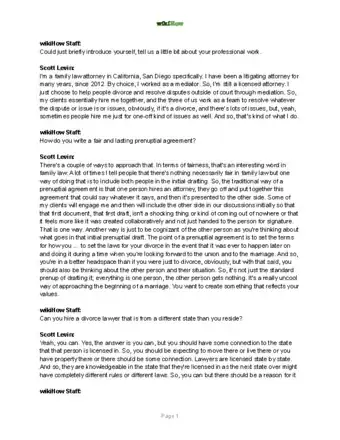
Thanks for reading our article! If you'd like to learn more about divorce processes, check out our in-depth interview with Scott Levin.
References
- ↑ https://www.helpguide.org/articles/abuse/getting-out-of-an-abusive-relationship.htm
- ↑ https://www.divorcemag.com/articles/safe-escape-strategies-to-use-when-escaping-an-abusive-marriage
- ↑ https://www.americanbar.org/groups/professional_responsibility/publications/model_rules_of_professional_conduct/rule_1_7_conflict_of_interest_current_clients/comment_on_rule_1_7/
- ↑ https://www.divorcemag.com/articles/safe-escape-strategies-to-use-when-escaping-an-abusive-marriage
- ↑ https://www.womenshealth.gov/relationships-and-safety/domestic-violence/leaving-abusive-relationship
- ↑ https://www.womenshealth.gov/relationships-and-safety/domestic-violence/getting-restraining-order
- ↑ https://www.womenshealth.gov/relationships-and-safety/domestic-violence/getting-restraining-order
- ↑ https://www.helpguide.org/articles/abuse/getting-out-of-an-abusive-relationship.htm
- ↑ https://www.helpguide.org/articles/abuse/getting-out-of-an-abusive-relationship.htm
- ↑ https://www.helpguide.org/articles/abuse/getting-out-of-an-abusive-relationship.htm
- ↑ https://www.womenshealth.gov/relationships-and-safety/domestic-violence/getting-restraining-order
- ↑ https://www.womenshealth.gov/relationships-and-safety/domestic-violence/getting-restraining-order
- ↑ https://www.courts.ca.gov/1278.htm?rdeLocaleAttr=en
- ↑ https://www.courts.ca.gov/1278.htm?rdeLocaleAttr=en
- ↑ https://www.courts.ca.gov/1278.htm?rdeLocaleAttr=en
- ↑ https://michiganlegalhelp.org/self-help-tools/family/domestic-violence-and-divorce
- ↑ https://www.courts.ca.gov/1229.htm
- ↑ https://michiganlegalhelp.org/self-help-tools/family/domestic-violence-and-divorce
- ↑ https://www.courts.ca.gov/1229.htm#panel8760
- ↑ https://www.courts.ca.gov/1238.htm
- ↑ https://www.courts.ca.gov/1238.htm
- ↑ https://www.womenshealth.gov/relationships-and-safety/domestic-violence/leaving-abusive-relationship









